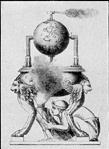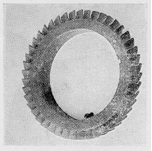Steam Powered Turbine Engine
Capturing the power of steam is not a new idea but one that has been used for hundreds of years. A jet of steam can readily do work on an object by the jet propolsion effect of steam escaping through a small guided hole or by a stream colliding with a system of paddle wheels. Most early steam powered machines used the principles of the latter. The system of paddles, or turbine, was used to drive a shaft which in turn could drive any number of gear or belt driven mechanisms. The circular saw, the cotton gin, screw shaft driven propellers on ships are a very few of the early creative uses for steam powered turbines.

http://www.history.rochester.edu/steam/parsons/
The conversion of steam to usable kinetic energy improved greatly in 1888
when Dr de Laval of Stockholm redesigned the shape of the jet so that the
expanding steam would increase in velocity thereby increasing the transfer
of energy to the turbine. More recent experiments have shown that around eighty
percent of the steams energy can be converted to kinetic energy by the use
of accelerating directional jets. Some of Dr de Laval's turbines turned at
speed up to half of that of the modern bullet! These speeds were two dangerous
to deal with and so the turbine redesigned to turn at speeds closer to the
speed of the mechanism being driven.

There are two types of steam powered turbines, the open cycle and the closed cycle systems. The open cycle system uses the water one time, returns it to its source, and replaces it with new. The closed cycle system uses the same liquid or water that is piped through a cooling source such as a lake or pond or cooling tower and the excess heat is transfered. Both types have distinct advantages and disadvantages. The closed cycle being more efficient and using very little liquid while the open cycle can create useful by-products such as distilled water for consumption or agriculture.

http://www.history.rochester.edu/steam/parsons/
HOME - INTRODUCTION - OTEC - TURBINE - PIPELINE - BIBLIOGRAPHY